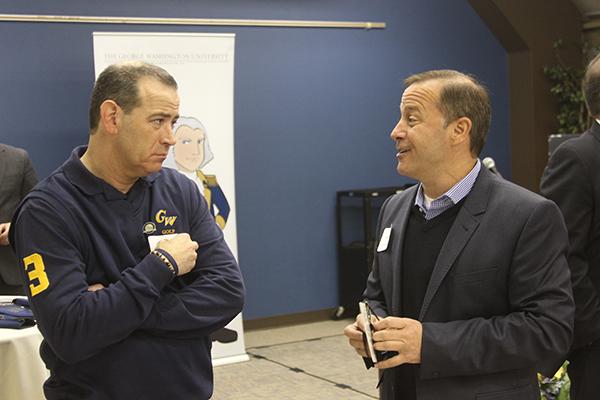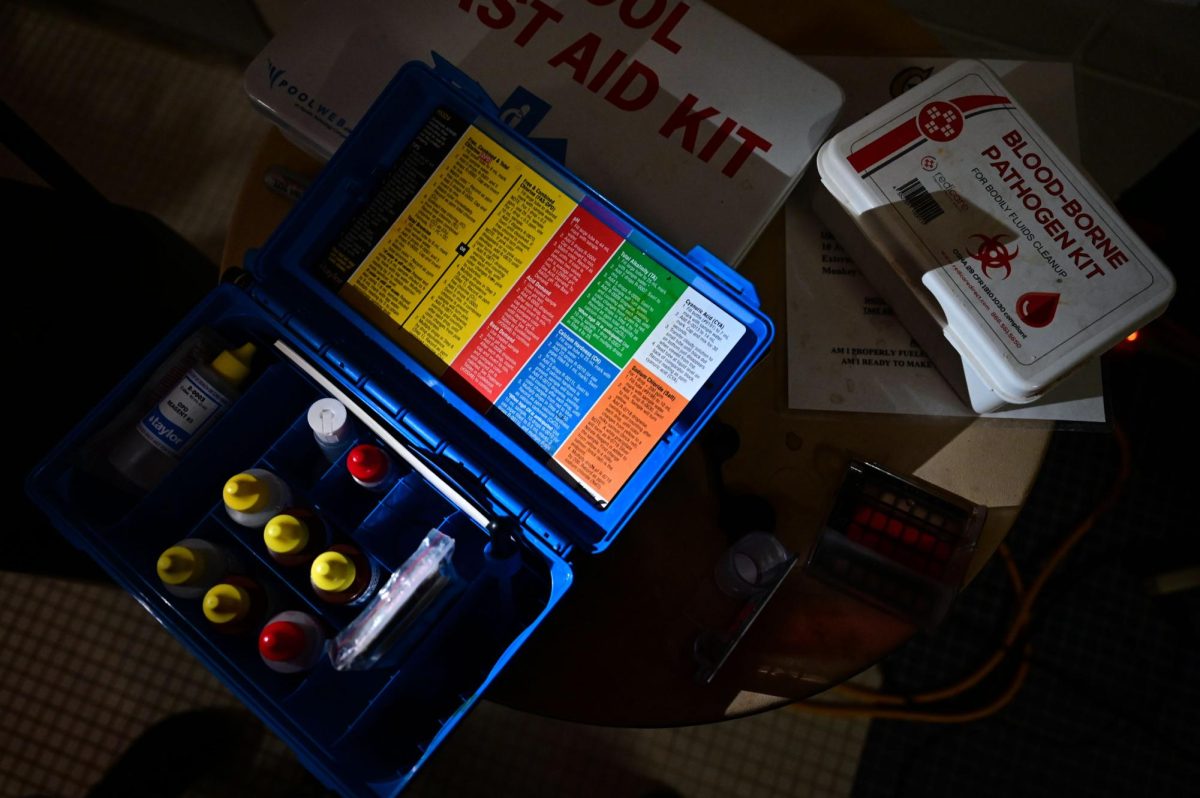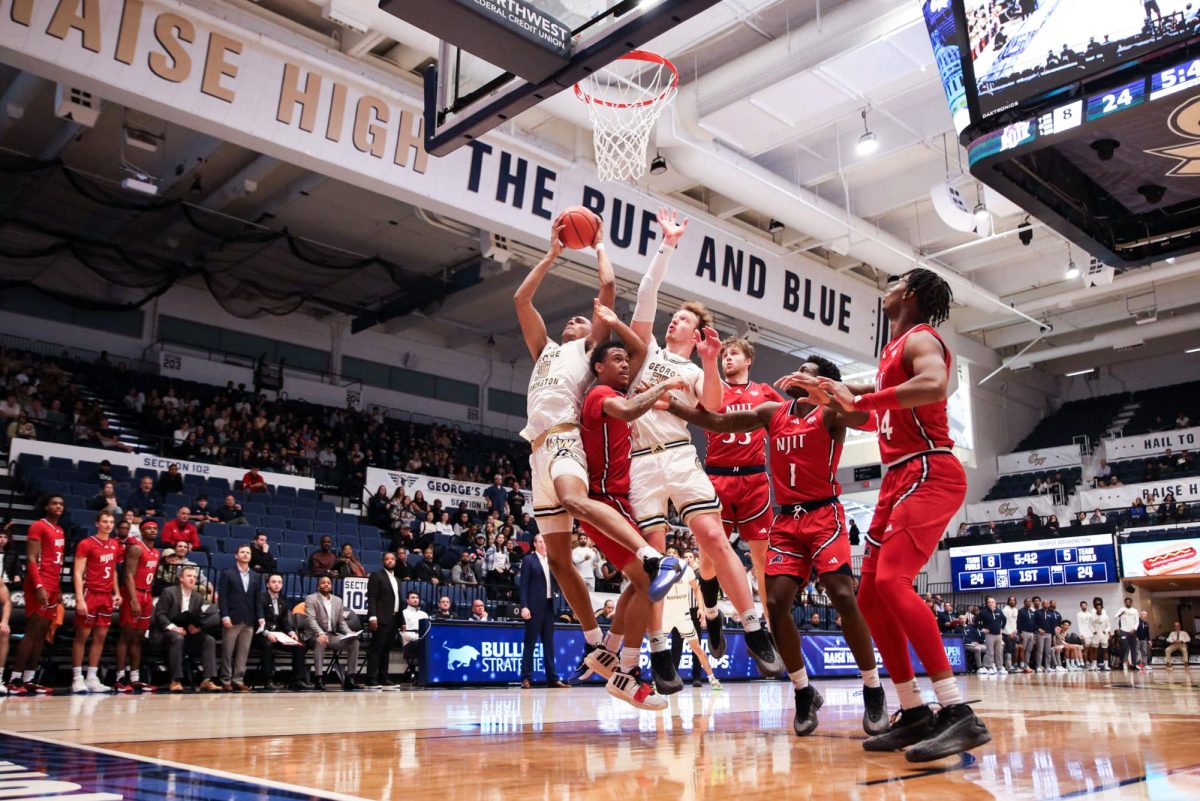PHILADELPHIA – Head coach Mike Lonergan has a ritual before most men’s basketball away games.
He visits a room of alumni sipping beers and huddled around tables, and delivers a three-minute speech about the trajectory of the team, the athletics department and the University as a whole. As GW was about to tip off against La Salle on Thursday, Lonergan first needed to connect with alumni.
“We want to return back to being a tournament team with a great tradition and great history at GW,” Lonergan told the group of 75 people. “So enjoy a couple beverages, bring your voices over there and I look forward to seeing you at the game.”
If the Colonials continue to win and make an NCAA Tournament run, even more alumni could flock to games – which could create big business for a university that has long lacked the financial benefits of big-time sports.
Already, GW’s hot start has increased attendance at home games by 20 percent and drawn more alumni to each pregame reception on the road this year, creating more opportunities for fundraisers to turn buff and blue fervor into green donations. About 400 alumni jammed into the Verizon Center last month before the BB&T Classic win over Maryland, while 225 visited a reception before GW’s game at Hofstra three weeks ago.

“This is where basketball has the opportunity,” Vice President for Development and Alumni Relations Mike Morsberger said. “When teams are winning and people are taking note, maybe they feel a little more inclined to be part of a winning team and give.”
A fundraising surge would be essential to the athletic department’s ambitious goal of increasing donation totals five times in the next five years – money that would add to teams’ budgets for travel, recruiting, training and leadership training.
The athletics department just beat its $1 million goal last year after adding staff and bolstering its budget.
But the office of third-year athletic director Patrick Nero won’t release data from previous years, when administrators admit fundraising efforts were paltry.
Annual gifts for athletics have been “relatively flat over the last 10 years,” according to the strategic plan drawn up by trustees and administrators two years ago. “Athletic annual giving efforts are underperforming compared with those of other [Atlantic 10] institutions by a factor greater than 2-to-1.”
Athletic powerhouse Virginia Commonwealth University raised $3.1 million for sports last year, while University of Dayton has averaged $6 million a year recently, according to their athletic departments.
The University is counting on the athletic department to turn that fundraising around to help meet its own lofty goals: a campaign that’s likely to tip past $1 billion starting this year. The excitement generated by winning teams would also benefit academic and scholarship programs, administrators say.
GW’s bottom line suffers from an alumni giving rate that trails behind most large private research universities, at least partially due to a campus culture that lacks allegiances shaped by a big-time football team. Only about 9 percent of alumni donate, while more than one-quarter of Northwestern University and Georgetown University graduates do.
By making waves in NCAA men’s basketball’s biggest tournaments – and building off buzz already taking hold in Sports Illustrated and ESPN – the men’s basketball team could help increase GW’s fundraising numbers. The Colonials are 13-3 this season, and have become a surprise favorite to make the NCAA Tournament for the first time in seven years.
When conference rival La Salle reached the Sweet 16 last year, fundraising went up by 18 percent.
“For anyone who’s been involved at a university that has successful athletics, be that big-time Division I or small-time Division III, they tell you that school spirit goes up, morale goes up, the sense of belonging to one’s alma mater goes up and fundraising goes up,” Morsberger said.
GW has now recruited a lineup of athletics department officials and fundraising officials who come from universities with a penchant for turning wins into cash. Nero and Morsberger each spent several years at University of Miami and Duke University, respectively, while Garrett Klassy, a new athletics official in charge of revenue, was hired away from fundraising-rich University of Oregon.
Steve Farmer, the new assistant athletic director for development who came from the University of Georgia, said his biggest challenge is quickly building a development team, calling his office still “short-staffed.”
He said he is on the verge of hiring a major gifts officer, who will be the office’s “road warrior” by traveling to potential alumni donors.

But more and more, alumni are coming to them.
In speeches in New York City and Philadelphia, Nero and Lonergan both talked up the team’s success, but also highlighted achievements of the sailing team and the high grade-point averages of GW athletes.
Joel Bolstein, a 1982 alumnus who works near Philadelphia, said winning records can drive attendance at these events. Bolstein said he gives back up to $2,500 each year to the golf team or the GW Law School.
“When you have a winning team, you end up packing a room like this,” Bolstein said before the La Salle game. “GW has a lot going for it other than sports, but it does raise the profile of the school. For years, GW did a horrible job trying to stay connected with alumni and it hurt them.”
– Josh Solomon reported from Hempstead, N.Y. and Cory Weinberg from Philadelphia.
This post was updated Jan. 13, 2014 to reflect the following correction:
In the caption, The Hatchet incorrectly identified Patrick Nero as being on the left. He is on the right.







